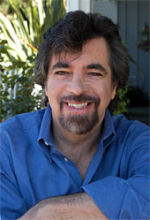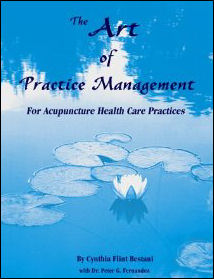Acupuncture & TCM Articles

Neil R. Gumenick is the founder and Director of The Institute of Classical Five-Element Acupuncture. Neil is a Worsley certified advanced teacher of Classical Five-Element Acupuncture and a practitioner with over 27 years of private practice experience. Neil holds three degrees from the College of Traditional Acupuncture (U.K.), and he participated for 10 years in the Master Apprentice Programô, led by Profs. J.R. & J.B. Worsley. Neil has taught at the USC and UCLA Schools of Medicine, the Worsley Institute of Classical Acupuncture, the Traditional Acupuncture Foundation, California Acupuncture College, Santa Barbara College of Oriental Medicine, and Pacific College of Oriental Medicine. He has been a Professor at Emperor's College of Traditional Oriental Medicine and SAMRA University of Oriental Medicine. Neil is co-author of The Art of Practice Management for Acupuncture Health Care Practices
The Initial Consultation: Getting to the Heart of the Matter, Part 3
By Neil Gumenick, MAc (UK), LAc, Dipl. Ac
In the two previous articles in this series, I stressed the importance of sensing the energy behind the words - how they are said, including the sound of the voice, expression on the face, body language, breathing and much more.
The "how" of a patient's expression is far more revealing than the "what." The "what" gives us information, but does not tell us "who" the unique individual patient is, and what they need in order to recover balance and harmony.
Although many patients will present physical symptoms as their main complaint(s), there are invariably concomitant mental, emotional and spiritual imbalances that must be addressed if we truly are to heal the whole person. In 28 years of practice, I have yet to see a patient who was only physically sick or imbalanced. Trauma on one level affects all.
In parts 1 and 2 of this series, I discussed how specific areas of inquiry can open up a wealth of information from which we can determine the patient's primary elemental imbalance (called the causative factor), as well as the level of the disease (physical, mental or spiritual) and what points are needed to provide for the patient's needs at all levels.

In this article, I will discuss the arrangement of the treatment room and its importance in creating the environment in which trust and rapport can most optimally be achieved, as well assisting us in our diagnosis. I also will discuss the inquiry about the patient's age. I gratefully acknowledge my teacher of nearly 25 years, the late Professor J.R. Worsley, for passing his knowledge and insights to me.
The Treatment Room Environment
After meeting and forming a first impression about you, the patient will next form impressions about the physical surroundings where the examination and treatment will take place. It is of primary importance that the treatment room be spotlessly clean and professional looking. This does not mean stark, cold or impersonal. The treatment room can be, in fact, quite cozy, colorful and inviting, but unquestionably professional. This translates into patient confidence.
If you treat from a residence, have your treatment room clearly apart and separate (or at least partitioned) from a bedroom, living room, den or other living space used for any other purpose. Invest in your treatment room. It will be an excellent use of even limited resources, as it says to patients, "Professionally, this is who I am."
The Seating Arrangement
Two equal chairs, one for you, one for the patient, set close to each other and slightly angled toward each other with no desk or barrier in between, is optimal. This creates an atmosphere of equality, placing neither you nor the patient in a superior or inferior position. Do recognize that, in the initial examination, you are establishing a relationship between two people who, in most instances, have not met before and do not know each other. Gaining the patient's trust and making them as comfortable as possible are crucial elements in creating the rapport needed for the patient to open themselves to you and let you see through to the "heart of the matter."
For some patients, chairs directly facing each other may seem too confrontational, forcing direct eye contact, which they may not be willing or ready to make. With the chairs close, but slightly angled toward each other, the patient may elect to move their chair to face you directly, or move their chair closer, farther away, adjust its angle or leave it as is. Any of these patient choices can be diagnostically significant. Why would a patient, for example, choose to move farther away or turn their chair to minimize eye contact? Is it shame, embarrassment, shyness, fear, weakness, isolation? Alternatively, if a patient opts for direct face-to-face contact, we also must note this. In some cases, it may be a sign of openness. In others, it may be a challenge or an indication of hostility.
Perceiving Emotion
While any single expression of behavior might not be diagnostically conclusive on its own, patterns will reveal themselves when woven together with the patient's expression over the course of a complete history and examination. In Classical Five-Element Acupuncture, repeated inappropriate expressions of emotion and sound of voice are keys to perceiving the elemental causative factor. For those who practice other styles, paying attention to these subtle (and sometimes extremely obvious) behaviors and expressions still is critically important. By these expressions, the patient is telling you who they are, what they need, and how you have to be in order to be at one with them.
Some patients need to be handled very delicately and gently. Others love a challenge and need firmness and authority. Others thrive on joviality. Some need acknowledgment, reassurance, sympathy and understanding. We also must have the emotional flexibility to react and shift emotional gears in response to all of the needs of patients. We will only perceive these needs if we are conscious of the need being expressed. And yes, it can be perceived by something as simple as what a patient does with their chair.
The Patient's Age
As children, after identifying ourselves by name, most of us were next asked, "How old are you?" Age was, and continues to be throughout our lives, a major component of our self-identity. How some patients relate to the fact of their age can be hugely significant.
This is particularly evident in our cultural preoccupation with youth. While children often wish to be older and bigger, adults often long to be young again, as evidenced by the proliferation of surgical anti-aging procedures, makeup, hair dye, diet fads and fashion trends, just to name a few.
What strikes my curiosity, in asking a new patient when they were born, is how they respond to the question. This is of far greater interest and significance than a date or a number. Some patients have difficulty even remembering their birth date. Such a response would register for me as unusual, and I would be moved to question deeper. I have asked questions such as, "It sounds like your birthday isn't a very special day for you. Is it?" On more than one occasion, a patient has answered, "I try not to think about it." I tend to respond with, "Tell me why," inviting the patient to share with me who they are; to reveal potentially significant and important information that easily could have been overlooked.
For many people, birthdays were and are hugely special. Did something happen to the patient that has caused them to forget or relegate the memory to unimportance? Some patients relate their age as if they wish they were a different age altogether. Why? What is wrong with now? What would be different or better if the patient were younger or older?
What would the patient have that they lack now? Such questioning communicates genuine interest and care for the patient as an individual, not just a collection of data. It further leads me to my treatment strategy and, along with pulse diagnosis, to my selection of points. If the patient does not wish to go into the topic, I merely make note of it and change the subject. It often has happened that with time, sensitive areas that were at first "off limits" are opened by the patient, and underlying feelings are revealed.
A Case Study
One Metal-imbalanced female patient told me after her third treatment, "When you asked me about my birthday, I wasn't able to tell you, or anyone, but for years, I have hated how old I am. My husband doesn't notice me anymore. We haven't been intimate for years."
Accompanied by a flood of tears, this was, for her, "the heart of the matter." It was the source of much of the stress and sadness in her life, as well as many of her health issues. She had been living in denial of this core self-hatred, distracting herself with a host of compensatory behaviors - predominately overeating and cruelty directed at her husband. She felt that treatment had brought these realizations to the surface and, having seen these internal mechanisms and beliefs with such clarity, she could no longer support them. In time and with appropriate treatment, she began to see her process with humor and compassion.
Incorporating such points as Lung 8, Meridian Gutter; Colon 4, Joining the Valleys; Lung 1, Middle Palace; and Colon 17, Heavenly Vessel, as well as transferring energy to her Metal meridians, as indicated by pulse diagnosis, she began releasing much of the internal debris and negativity that had plagued her. She began to experience her own radiance within - the spiritual part of herself that was ageless, eternal and incorruptible. As the load on her psyche lessened, so did her physical weight, as well as the heaviness in her relationship, which became one of joy and true intimacy.
 
The Art of Practice Management for Acupuncture Health Care Practices
What you will find in this book is a specific, comprehensive approach that gets to the root cause of success in practice.
This new book presents acupuncture practice as art from the standpoint of centering, qi, and wholeness. It builds on the premise that practices succeed from bridging inner and outer aspects of the self. It is an inquiry into the self and addresses clear understandings and approaches to reputable patient care and practice qi. It brings in the five elements and work with the seasons of practice from training and start-up to growth, stability, expansion and transformation. The authors artfully bridges the essence of both patient and practitioner well-being without excluding the practicalities of financial well-being. This book very specifically and extensively shows how the different parts of practice nourish and feed one another and are interdependent on one another for the qi to flow synchronistically.
It explores the dual nature of procedures that work and those which do not in acupuncture health care practice, returning again and again to the delicate balance of practicality and spirituality.
|
